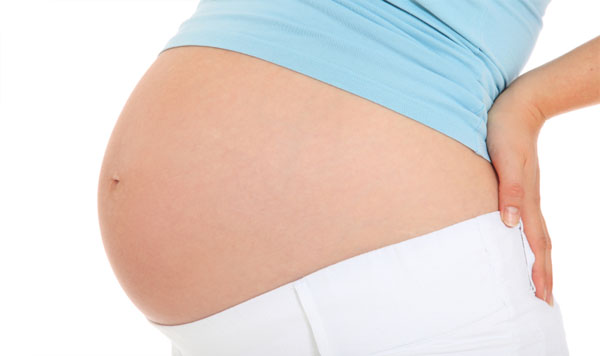Pubic symphysitis during pregnancy
Pubic articulation, which is popularly known as pubis, is called symphysis in medicine. Normally it is fixed, but in certain circumstances it may swell and become mobile, which is already a pathology called pubic symphysitis.

Pubic symphysitis causes
Doctors cannot answer why this happens. Most doctors agree that pubic symphysitis is caused by calcium deficiency. However, hormonal changes during pregnancy also matter. Under the influence of the hormone relaxin all bones slightly soften and the pubic joint stretches. This is a natural process. Your body prepares an easier passage through patrimonial ways for your baby. However, if the pubic joint swells and becomes movable, and the pubic bones diverge excessively — pubic symphysitis is diagnosed.
There is also a belief that this pathology is caused by hereditary factors, as well as by problems with the musculoskeletal system in the pre-pregnancy period.
Symptoms of pubic symphysitis during pregnancy
Usually pubic symphysitis manifests itself in later periods of pregnancy — at the end of the second or, more frequently, in the third trimester of pregnancy. Characteristic symptoms of pubic symphysitis are:
- severe swelling in the area of the symphysis;
- feeling of pain and characteristic clicks when pressing on the pubic bone;
- pain in the pelvis, pubic bone, groin, tailbone, thigh;
- sharp pain while changing your body position;
- inability to raise extended legs in supine position;
- typical «duck-like» gait;
- walking with small steps;
- heaviness and pain while going up and down the stairs.
With the development of this pathology pain increases, it becomes more and more pronounced and occurs not only when walking, but also in a passive state — in the position of sitting or lying. As x-ray is contraindicated during pregnancy, doctors make a diagnosis of pubic symphysitis on the basis of its symptoms. They observe pregnant women and listen to their complaints.
Self-diagnose of pubic symphysitis is imposible because during pregnancy similar pain can be caused by other disorders, for example, by changes in your sacroiliac or hip joints. If a pregnant woman suffers from pubic symphysitis, she runs a high risk of rupture during natural childbirth. In such situations, doctors insist on caesarean section.
During examination, the GP will determine the severity of pubic symphysitis and will refer the woman to an additional ultrasound.
Pubic symphysitis treatment
The good news is that pubic symphysitis has no effect on the development and health of your baby. Shortly after childbirth, the problem will disappear. However, before that pregnant women need to live with it. Pubic symphysitis is dangerous if its signs are severe at the time of delivery. There is a high risk of separation of symphysis pubis during childbirth, which will require long-term rehabilitation in the future. Natural childbirth is possible if the pubic slit is not more than 10 mm, the fetus is medium-sized, and the pelvis of a pregnant woman is of a normal size.
It’s difficult to treat pubic symphysitis. Most likely, you won’t get rid of it during pregnancy, but you can significantly reduce its symptoms and your discomfort.
First, the GP will prescribe you a vitamin complex with high calcium content. However, it is forbidden to take calcium supplements in the third trimester. Too much calcium can lead to several complications. Some doctors even recommend excluding calcium-containing products from the diet at the end of pregnancy. Additional calcium can bring relief to women with pubic symphysitis. However, strengthening of bones, which are now slightly moving apart to simplify your childbirth process, is no good. Now it’s better for your bones to be more flexible. Calcium makes the baby’s skull more strong and solid — this is also undesirable before birth.
You may have to take special anti-inflammatory drugs or even go to hospital. Pregnant women with pubic symphysitis need to wear a special abdominal support. You must limit your physical activity.
Physical exercises in pubic symphysitis treatment
Special physical exercises that strengthen the muscles of pelvis, lower back and hips are very useful.
Exercise 1
Position: lying on back, knees bent, feet close to the buttocks. Slowly, as if overcoming resistance, but very symmetrical move knees apart and again bring them together. Repeat 6 times.
Exercise 2
Similar position, only your feet are slightly further away from the buttocks. Slowly raise your pelvis up, and very slowly drop it back. When the coccyx is already touching the floor, stay in this position as long as possible. Repeat 6 times. In the third trimester, don’t raise your pelvis high.
Exercise 3
Cat position. For this exercise you should kneel and lean on your hands. Relax the muscles of your back, head, neck and spine should be at the same level. Next, arch your back up, with the head lowered down. Strain the abdominal and hip muscles. Repeat 2−3 times.
These exercises should be done several times a day, especially when pain increases.
Also, follow some simple recommendations to help alleviate the pain and not to provoke complications. Avoid asymmetric positions of the body: don’t cross your legs while sitting. Do not lean on one leg, distribute your weight evenly on both feet. Don’t sit and lie on hard surfaces. Do not sit for long hours. Do not sit with your knees above the pelvis. Use a chair with adjustable backrest and armrests.
Avoid prolonged staying on the feet: don’t walk long hours. Don’t walk up and down the stairs much. Avoid steps aside: try only to walk back and forth.
If, lying in bed, turning from side to side causes pain in the pubic area, first turn your shoulders and upper body, and only then your pelvis. Try to reduce the pressure of the fetus on the pubic area: put an extra pillow under your buttocks, lift the pelvis, put your feet up. During bouts of pain sit into a chair or lie on your back on the bed. Monitor your weight gain: extra pounds will exacerbate the condition. If you do all of the recommendations and it doesn’t bring relief — tell your GP about it. Perhaps, in your situation appropriate inpatient treatment and professional chiropractic will help.




